Football/Soccer Session (Moderate): 4-1-3-2 Formation
Profile Summary
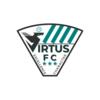
| Name: | Darren Kalthoff |
|---|---|
| City: | Grain Valley |
| Country: | United States of America |
| Membership: | Adult Member |
| Sport: | Football/Soccer |
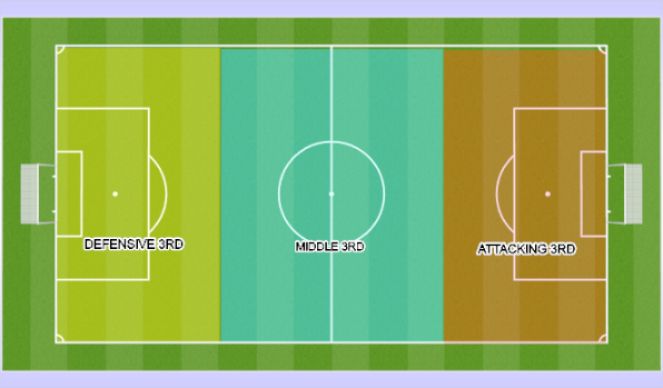
See the guidance at the top of this page to understand why you are not seeing interactive Football/Soccer images.

3rds
At VFC we break the field down in horizontal thirds too. Defensive, Middle, and Attacking.
Rule one, we defend and attack as a team. All positions are involved. Keep this in mind
• Defensive Third
This is where our formation becomes a 4-4-2. This is where we are patient but fierce. One person goes to the ball carrier while the rest of the team stays tight, flat, and patient. When the pressuring player is beaten, the next closest player steps to the ball. Our goal is to keep the other team out of our box. I do not want you drifting back and setting up in our box. Try to keep the opponent out of the middle, and out of our box, Any ball that is won is passed up the field and wide to the widest player. If there are no passing options, the ball is cleared up and wide out of bounds.
Our tempo (speed of play) is fast one to two-touch passing. Get the ball up the field to the Middle third quickly.
• Middle Third
This is where we use the width and depth of the formation. The width is how wide we are in the formation and our depth is the distance from the centerbacks to the forwards, In this part of the field our centerbacks will drop and form a "horseshoe" or "U" shape. This is for our trail passing to break a press from the opponent and to make collecting a direct over-the-top kick from the opponent on a quick transition. We start the build-up to attack here.
• Attacking Third
This is where we need creativity and fearlessness. The back line steps up past the half line, and the holding mid steps down in the formation towards the box. The CAM is in the box with the forwards, and the wings are on the outer edges of the box creating width to open spaces for through balls. We want a lot of off-ball movement, passing, and shooting. Any shot taken must be followed up with players crashing. If the Left Wing takes a shot, both forwards and the CAM crash. The Right Wing will crash the back post. We all attack. The holding mid is there for a layoff pass at the top of the 18. If the attack needs to be reset, the ball can be trailed to the back line. If the ball is trailed to the back line, the outside backs are looking to cross the ball, diagonally into the box. The Centerbacks are looking to put the ball back into the attack by finding any attacking player that is unmarked.
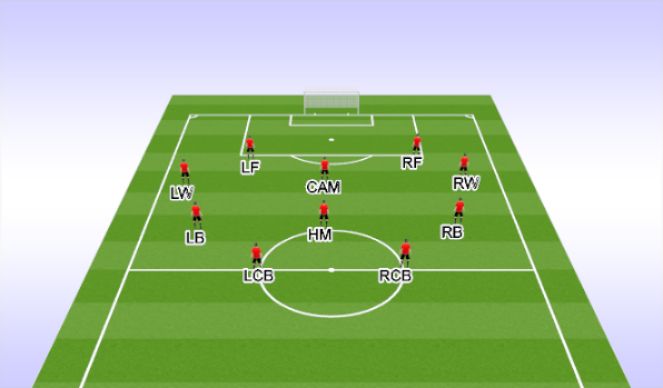
See the guidance at the top of this page to understand why you are not seeing interactive Football/Soccer images.

Positional Roles
Forwards:LF=Left Forward
RF= Right Forward
The forwards are the forwardmost players in the formation. Their main responsibilities are creativity in the opponent's half, taking shots on goal, and harassing the opponent's back line when a ball is trailed to the defenders when the opponent is in possession. They must read their wings and CAM. If the wings are wide, the forwards should move slightly toward the middle of the field. If the wings are inside, the forwards should move wide of wings. Defensively the forwards harass and attack the ball in the middle third when we are out of possession.CAM:
CAM= CENTER ATTACKING MID
The center attacking mid, or the CAM is the attacking midfielder. At VFC we train them to be the 'False 9" meaning that they become the center forward or Stryker on the attack. Their runs must be timed and precise to catch the back line off guard and keep them off balance. They are responsible for distribution in the midfield. They must have an acute awareness of their teammates and the opponent's team, as well as ball handling, accurate passing, and great spatial awareness (where they are in the formation and on the field). In defense, they are aggressive in attacking anyone in the midfield who is in possession.
HM:
HM=HOLDING MID
The holding mid is the defensive midfielder, like the CAM, they need great spatial awareness, accurate passing, good ball control, and fearlessness. They are the axis of the formation, meaning that they are the inside option when switching the play through the middle. Defensively they are in charge of delaying and containing the play in the middle of the field to allow our back line to get set. They need to be patient, fierce, and fast. Wings:RW=RIGHT WING (MIDFIELDER)
LW=LEFT WING (MIDFIELDER)
Wings need to be fast, have great conditioning, and be ready to play box-to-box. They are the widest midfielder. They control the side channels and will touch the ball the most in our style of play. They need a good understanding of how their spatial position affects the formation. Receiving passes, accurate passing, diagonal runs, and crossing the ball are their primary responsibilities. Defensively they are "the edge" of the midfield formation and are responsible for attacking any wide player down the channel. DEFENSIVE BACKS:RCB= RIGHT CENTER BACK
LCB=LEFT CENTER BACK
RB=RIGHT BACK
LB=LEFT BACK
The defensive backs need to be smart, fast, aggressive, and fearless. They are as much a part of the offensive attack as they are the defense. The RB and LB are fullbacks, meaning they are playing the full length of the side channel. They are the second wing on their side of the field. Receiving passes, creating diagonal and overlapping runs, and distributing the ball are their responsibilities. Defensively they collect balls, close down players, show aggression, and win the ball back.The Center Backs are the heart of the defense. They need to be fast, aggressive, and fearless. They need to be great ball handlers, and have great spatial awareness, passing accuracy, and excellent understanding of the formation. They control the defensive line. Ball distribution is their focus on attack, long diagonal passes, or firm vertical passes to the CAM or HM to split the opponent's midfield. Defensively they collect balls, attack the ball carrier, and control the depth of the back line.
GOALKEEPER:
GK= GOALKEEPER
Protects the goal box in defense. Must be fearless and have great passing and foot skills. In attack, they move out of the box and become the deepest trail option for the formation. and ball distribution is key for a keeper. Place kicks, punting, throws, and passing are their weapons.
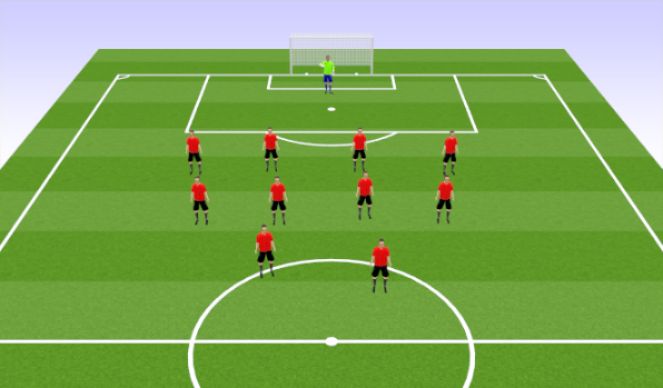
See the guidance at the top of this page to understand why you are not seeing interactive Football/Soccer images.

Defensive formation.
Defensive Formation: 4-4-2
We are compact, flat, and patient. The forwards and midfielders are applying the pressure to allow the back line to get set. The center backs control the formation. Giving instructions, being vocal, and shifting the formation. An important aspect of the 4-4-2 is the forwards. My forwards will not stand and watch or wait for the easy pass at the top of our half. They are working hard to win the ball back.
The midfielders are the first line of defense to the attack. The outside mids apply the pressure to any ball played into the outside channels on the attack. The rest of the team protects the center channel. The wings and outside backs have to talk and communicate. If the outside back pressures the wide ball, the wide mid has to step into the outside back's space. If the wing steps out to pressure the wide play, the outside back stays in to protect the middle. Only pressuring the ball when the opponents wing dribbles into the box.
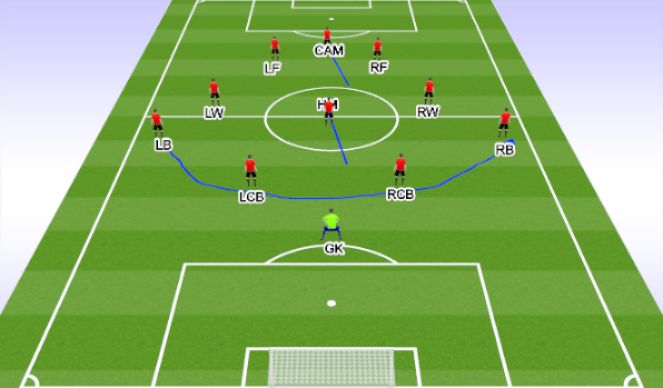
See the guidance at the top of this page to understand why you are not seeing interactive Football/Soccer images.

Build up
BUILD UP
On the build-up, we are looking to the wide players first. We want to force the opponent's defensive formation to break and spread out. We become a 4-3-3 on the build-up to attack. The CAM becomes the center forward, the holding mid becomes the center mid. The depth of the formation comes from both center backs and full backs creating the "u" shape.
The center backs have to maintain their depth even after we get into the box. They are the trail option to reset the attack. Behind them is the keeper who is the trail for the CBs if there is a high press on them. The wings need to read the forwards, if the forwards are wide, they need to be inside of them. If the wide forwards are inside the wings need to be outside of the forwards. This is to maintain the diamond and triangle passing patterns.
The tempo starts to pick up in the build-up. One to two-touch passing, overlapping runs, underlapping runs, give-and-gos, trail passes, and through balls.
The Holding mid will become the CDM in the 4-3-3, being the point of the triangle the wings and cam form. This is so the ball can still be played through the middle to the wing or outside back.
The "target" player(s) are the three forwards. We are looking to get the ball into the box for them. Once we are deep into the attacking third, our formation becomes more aggressive with 7 players in or around the box. This could leave us vulnerable to counterattack. Players will have to be cognizant of where they are in space relative to the ball and who has possession. If possession is lost by us we must win the ball back quickly.
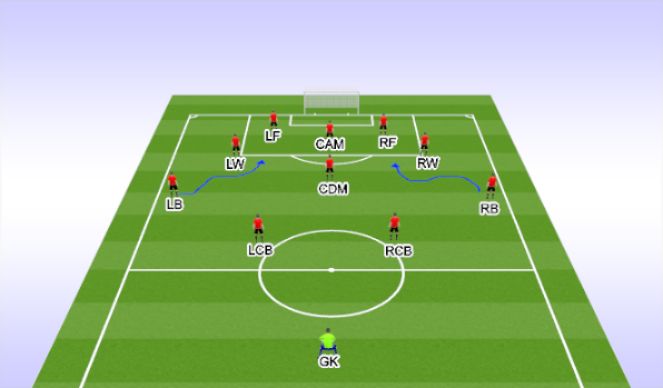
See the guidance at the top of this page to understand why you are not seeing interactive Football/Soccer images.

Attack
ATTACK
On attack, we are creative, aggressive, and fearless. Do not be afraid to take chances. Total "free play" is expected, any position can become another as long as the player's space you move into goes to your space. Take shots and players must crash the keeper on every shot. If the Right Wing takes the shot from the right half of the 18-yard box, we want to see all three forwards and the left-wing crashing. The forwards take the middle of the penalty area while the left-wing crashes the post on a diagonal run.
This will leave us vulnerable to a counterattack. I am willing to take that chance if you are playing aggressive, smart soccer.
Notice the number of players in and around the box. The blue lines from the fullbacks show the potential runs they could make if the ball is trailed to them. I would like them to take the space given to them and then put a diagonal cross into the box. If the RB runs in, the left back stays wide, and vice versa. I would also like to see the formation shift a little when that happens. The center backs and the left back would shift toward the space the right back vacated when they made the run toward the box.
The backs are your trail pass players, as well as putting balls into service, (through balls, crosses). The CDM is the trail option for the players in the box. If the CDM sees an opportunity to take a shot, I want them to take it. If they see an option to over or underlap a forward in the box I want them to take it. The wings serve as the widest player to try to stretch the defense in the box. If the CDM is passed the ball, the right or left wing can step toward the sideline to create width. Forcing a defender to step that way will open a space for an attack. The RB can run diagonally and then put a cross in for just one example.
The target players are the forwards. I want creativity to get the ball to them. Chips, through balls, crosses, and flicks are the keys here. Find a way to get the ball through the defense and on the foot of a forward.
Remember to shoot. You miss 100 percent of the shots you don't take.
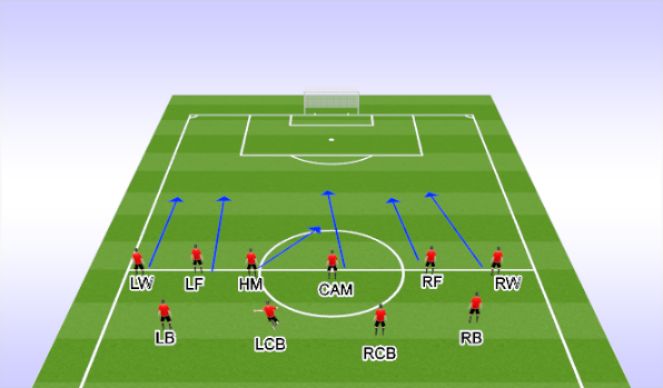
See the guidance at the top of this page to understand why you are not seeing interactive Football/Soccer images.

Kick-off
KICK-OFF
This is our kick-off formation. We can overload either side, it's up to you. The important thing is that the six on the line sprint as soon as the ball is kicked. The backs are looking to play it deep in the opponent's third, preferably to a corner. We are looking to pin them down there and put pressure on them. We immediately move into our attacking formation down here.
It does make us vulnerable to a long ball and quick transition. Our backs have to be ready to drop and collect a long kick.
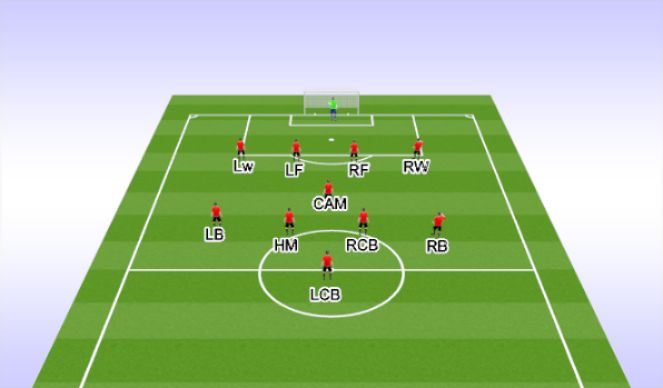
See the guidance at the top of this page to understand why you are not seeing interactive Football/Soccer images.

Defending a goal kick
Defending a goal kick
We will use a 1-4-1-4 formation to defend a goal kick. We are looking to take all available space away from the keeper. Force her to make a kick she doesnt want. We also want win the ball immediately to keep it down in the opponents third. I want the entire team to be aggressive in winning the ball in the air and on the ground. We do not want to allow them to break out and start an attack.
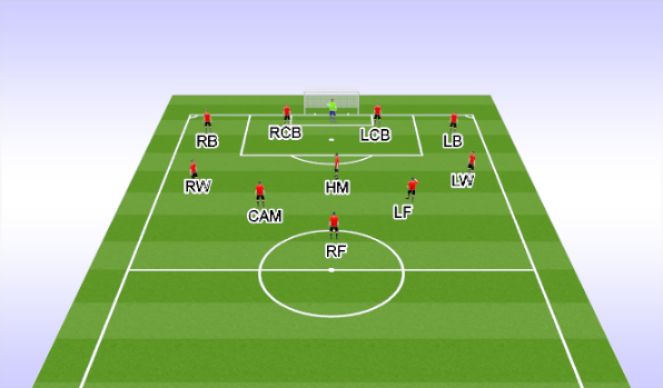
See the guidance at the top of this page to understand why you are not seeing interactive Football/Soccer images.

Goal Kick
GOAL KICKS;
The key to keeping possession of goal kicks is movement. The HM and wings need to be ready to move. When the ball is played they need to move to support the pass. We are looking to break out of our defensive third with quick, one to two-touch passing to the middle third of the field. The team has to move as quickly as the ball. If the keeper sees an opportunity to play it long, she should look to hit the wings, the cam, or the LF with a ball in the half space (space between the defender and our player.
The focus is finding the best pass to the open player that keeps the ball safe and allows us to move it forward. Dont rush the kick, scan the field and find your options.







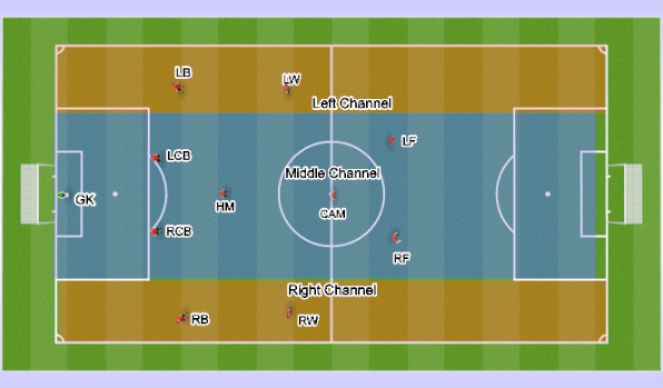
 Play animation
Play animation Play step-by-step
Play step-by-step Repeat (toggle)
Repeat (toggle) Full Screen
Full Screen Pause
Pause Stop
Stop
Channels
At VFC we break the field into three vertical channels. The left, middle, and right channels.
• Left/Right Channels
This is the space our outside backs, wings, and forwards play in. This is where our IOIO (inside-outside-inside-outside) style of play starts. We keep the ball wide in these channels to force the opponent to stretch their formation and create gaps (Breaking the lines)
We use our width to create depth. We want to force the opponent to create space where we can use off-ball movement, superior passing, and tactics to gain an advantage in possessions and attacks on goal.
• Middle Channel
This is the strength of our formation. The CAM (center attacking mid), the HM (holding mid), the Wingers (Right & Left Midfielders), and the Centerbacks, create the axis, focusing mainly on the HM, to move the ball through the middle.
We want to control this channel defensively and create attacks here offensively.